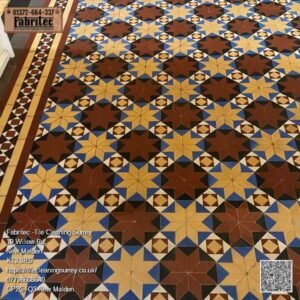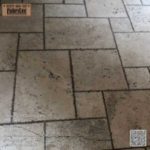Understanding the Consequences of Neglected Victorian Tiles

Allow me to recount a tale of a neglected Victorian hallway in Chertsey, which stands as a testament to the consequences of inadequate maintenance. Initially, these tiles boasted a lustrous shine and aesthetic appeal; however, over the years, they succumbed to neglect following a hasty wax treatment. The once vibrant surface gradually transformed into a dull and lifeless expanse, with the wax layer becoming marred by scratches and discolouration, resulting in a sad, worn-out appearance that detracted from the grand character of the hallway.
Upon inspecting the hallway, I felt relieved to find that the tiles were still in a relatively decent condition overall—no need for replacements, thankfully! However, a significant task awaited us. My recommendation involved the challenging removal of the stubborn wax layer, followed by a thorough deep clean of the floor, and finally, applying a modern sealer that would allow the tiles to breathe properly. After preparing a detailed quote for my client, they agreed enthusiastically, and we scheduled a date to commence the necessary work. Let’s explore the meticulous cleaning process together!
Step-by-Step Guide to Cleaning a Victorian Tiled Hallway
Here’s how I methodically approached this project. I divided the work into manageable sections, which significantly eased the task. Initially, I applied a concentrated mixture of tile cleaner and wax remover directly onto the tiles, diluting it with some water to prevent it from drying out too rapidly. This particular product is a robust cleaner designed to tackle tough wax build-up. Using hand tools, I carefully scraped off the wax, and let me assure you, it was quite a messy undertaking!
The waste produced? Well, it predominantly resembled a brown sludge—quite an attractive sight, wouldn’t you say? I employed a scrubbing brush to remove the majority of it and then reapplied the cleaner, this time mixing in a bit more water. Allowing the solution to soak for approximately ten minutes proved vital to effectively break down any remaining wax residue.
Following this, I utilised a powerful tool: a scrubbing brush connected to a rotary machine. This remarkable machine worked wonders, scrubbing away any lingering wax remnants. Subsequently, I brought in a wet vacuum to efficiently suck up all the sludge, making the cleaning process reminiscent of tidying up after a particularly messy toddler—less glitter, more grime!
The Importance of Moisture Control for Victorian Floors
Now, here’s an essential factor to keep in mind: traditional Victorian floors lack a damp proof membrane. This absence means that moisture can rise from the ground, which can lead to detrimental consequences. Trapping moisture beneath the tiles can result in rising damp and a host of other unwelcome issues, making moisture management crucial for the longevity of the flooring.
After successfully removing the wax, I found myself somewhat concerned about potential moisture accumulation beneath the floor. If moisture rises, it can carry salts with it, resulting in a condition known as efflorescence, which can mar the beauty of those exquisite tiles, leaving them streaky and stained. To mitigate this risk, I rinsed the floor thoroughly with fresh water and applied a gentle acid wash. This specialised formula cleans the tiles and neutralises any salts present. Following another rinse to ensure no residues remained, I dried the floor as much as possible and allowed it to dry overnight.
Applying the Sealer: Ensuring Long-lasting Protection
The following day, I returned to check the tiles with a moisture meter—this step is critically important! It's vital to ensure that the tiles are adequately dry before applying any sealer. Applying a sealer to damp tiles can result in a patchy finish, and that’s certainly not the desired outcome!
I proceeded to apply four coats of a colour-enhancing impregnating sealer, ensuring a drying time of thirty minutes between each application. This sealer is water-based, which meant there were no unpleasant odours during the drying process. It works exceptionally well on Victorian tiles and provides a lovely, subtle silky finish that enhances their natural beauty.
Once I completed the application of the sealer and took a moment to step back, the transformation was truly remarkable! A short while later, my client texted me to express their delight: “Thank you so much for the lovely job. I never believed my floor could look so nice.”

Essential Aftercare Tips for Maintaining Victorian Tiles
If you’re fortunate enough to have Victorian tiles in your home, I cannot stress enough the importance of using a pH neutral cleaner such as LTP Floorshine or Fila Neutral Cleaner to maintain their condition. These cleaners are both gentle and effective—and being pH neutral means they won’t compromise the integrity of the sealer, which is paramount compared to conventional floor cleaners. Trust me, you really don’t want to jeopardise all that hard work!
Celebrating a Successful Restoration: A Job Well Done
So, there you have it! Restoring this Victorian hallway was no simple feat, but the end result was undoubtedly worth the effort. These historic floors possess immense character, and it’s incredibly rewarding to breathe new life into them. After all, who wouldn’t relish the experience of walking into a beautifully restored hallway every single day?
If you require professional assistance, don’t hesitate to contact Fabritec Tile Cleaning at 01337-664-337, or visit our website at https://tilecleaningsurrey.co.uk.
The post Uncover the Shocking Transformation of a Neglected Victorian Hallway In Chertsey! appeared first on https://tilecleaningsurrey.co.uk.


I can really relate to the story of those Victorian tiles! It’s fascinating how something that started off so beautiful can lose its charm due to neglect. I recently tackled a similar issue with my own home; the tiles were covered in years of grime and old polish, and it felt like uncovering a lost treasure once I got them cleaned up! It’s such a rewarding process to restore their original beauty.
It’s so great to hear that you had a similar experience with your tiles! There’s something almost magical about peeling away layers of grime and revealing the beauty underneath. It’s like you’re connecting with the history of the space. Restoring those details not only brings back the charm but also brings a deeper sense of appreciation for what’s been hidden for so long. Did you come across any interesting patterns or colors that surprised you during your cleaning? Sometimes those unexpected details tell such rich stories about the house itself.
I’m so glad you can relate! If you’re interested in tips and resources to help with restoration projects like yours, check out this helpful guide. It might just inspire your next adventure!
https://fabritec.org/lp
It’s interesting how these old tiles have their own stories to tell, isn’t it? Your experience with restoring the tiles in your home mirrors the journey of those Victorian tiles quite closely. Over time, beauty can get hidden beneath layers of neglect—whether it’s grime, polish, or just the passage of time. It sounds like you really embraced the challenge, and the idea of ‘uncovering a lost treasure’ perfectly captures the satisfaction of engaging with historical craftsmanship.
It’s truly fascinating to read about the journey of the Victorian tiles in Chertsey, particularly regarding how neglect can lead to such a significant transformation in not only their appearance but also their functionality. Your account serves as a poignant reminder of the importance of regular maintenance, especially for historical features that often carry so much character and nostalgia.
Your recounting of the Victorian hallway’s decline really highlights the delicate balance between beauty and maintenance in heritage spaces. I’ve encountered similar situations in my own home, where initial charm can be easily overshadowed by neglect or improper treatment. It’s intriguing how materials like Victorian tiles, which carry the weight of history, can be so sensitive to modern cleaning products or techniques.
You’ve really captured the essence of the struggle with maintaining heritage spaces. The charm of those Victorian tiles is undeniable, but it’s surprising how quickly that beauty can fade if they aren’t treated with care. I’ve noticed similar issues in my home as well, especially with some older woodwork that just doesn’t respond well to modern finishes or cleaning methods. It makes you appreciate the craftsmanship that went into those designs in the first place.
I can totally relate to your experiences with heritage spaces; I found some practical tips recently on caring for Victorian tiles that really emphasize maintaining their charm without risking damage.
‘Victorian Tile Cleaning Tips for a Pristine Home’
https://fabritec.org/victorian-tile-cleaning-tips-for-a-pristine-home/.
Ah, the tale of neglected Victorian tiles—truly a narrative that resonates on a personal level. It brings to mind my own misadventures in tile maintenance. I once inherited a charming but rather tragic-looking ceramic floor from my grandmother, who, bless her heart, thought that a gleaming layer of bright orange wax would turn the tiles into a disco floor. Spoiler alert: it did not. What transpired was more akin to a 1970s dance party gone terribly wrong, complete with scratches and a hint of mildew. I can still hear the echoes of my attempts to scrub that wax off, armed with only a bucket of hot water and a misguided sense of optimism!
It’s fascinating to hear about the journey of those Victorian tiles in Chertsey. Your description really brought the visual transformation to life. It’s a striking reminder of how neglect can so easily overshadow craftsmanship, especially with materials rich in character and history like these tiles. I’ve always been intrigued by Victorian interiors; there’s something about their intricate designs that feels almost timeless.
I’m glad you enjoyed the journey of those Victorian tiles. The story of neglect and rediscovery is so rich, don’t you think? Each tile carries a piece of history, and it’s intriguing to ponder how many hands have touched them over the years.
It’s interesting how a simple wax treatment can have such long-lasting effects on Victorian tiles. It reminds me of how often we overlook preventive maintenance in both our homes and broader systems—like urban infrastructure or even our own health. Just as neglecting these beautiful tiles leads to their deterioration, ignoring routine care in other areas can lead to much larger issues down the line.
I found your recounting of the neglected Victorian hallway in Chertsey quite poignant and reminiscent of the stories many of us have encountered in older homes. It’s interesting how the initial beauty of those tiles can be so easily overshadowed by neglect and improper maintenance practices. It reminds me of the importance of preserving our historical architecture, as each piece tells a story of its own, and when we neglect these details, we risk losing parts of our cultural heritage.